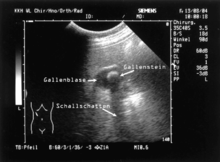Sonic shadows
An acoustic shadow (Engl. Acoustic shadow ) or sound absorption overshadowing arises when on the direct sound away from the sound source to the listener or microphone are obstacles such. B. pillars or people. The resulting shadowing (shadow space ) is an area of reduced sound pressure or sound pressure level on the side of the obstacle facing away from the sound source.
Shadow border
All sound components with a wavelength greater than the extent of the obstacle are bent around the obstacle . The sound shadow is "brightened" by this sound diffraction, it is therefore - as with the diffraction of light - not a sharp shadow , but a wide zone with more or less pronounced sound discoloration, i. H. “Dulling” of the sound. The sound boundary or shadow boundary is more or less blurred.
calculation
The effect of an obstacle in the sound field is greater the larger the obstacle:
- if the diameter of the obstacle is only twice as large as the wavelength λ , then the sound is still almost completely diffracted around the obstacle.
- Only when the extent d of the obstacle is greater than five times the wavelength does an audibly evaporating sound shadow arise for the frequency f and higher. The shadow limit is therefore:
- with the speed of sound c = 343 m / s at 20 ° C.
Shadowing of the auricles
With the head as an obstacle, the auricles shade each other. Due to the small ear distance d = 21 cm, the acoustic shadow only becomes effective from a very high frequency:
- = 5343 m / s / 0.21 m = 8200 Hz
This results in shifts in the frequency response that enable the ear to distinguish not only - via the running time and the level - right from left, but also front from behind and above from below ( directional hearing ). This effect is created, for example, in surround sound simulations using suitable high-pass filters on certain channels .
Room acoustics and sound insulation
In order to take advantage of the acoustic shadow, partitions are often used in practice as acoustic barriers for the acoustic separation of the sound waves. The penetration of sound into the shadow area behind the obstacle due to diffraction effects is responsible for the limited effect of such sound screens.
Effectiveness of a shield

d is the direct distance between source and receiver.
In 1968 the Japanese Maekawa presented a model for calculating the sound insulation on long, flat walls. A series of measurements served as the basis, the results of which were expressed as a function of the Fresnel number known from optics . The result is an empirical law according to which one can calculate the sound level difference caused by the obstacle.
With
- the Fresnel number
- the path difference between the line of sight and the indirect path around the obstacle.
All points that are below the line of sight of the source have a level reduction of at least 5 dB.
The model also allows negative Fresnel numbers down to -0.1 for points above the line of sight:
Since this law was only determined empirically, it has a limited area of application: Distances of less than 100 m between the noise source and receiver as well as noise obstacles of at least 1 m height. The distance plays a decisive role, since for such short distances it can be assumed that the noise propagation is approximately linear - weather phenomena and temperature gradients have no influence yet.
medicine
In sonography , the image erasure behind a highly reflective ("echo-rich") structure is called a sound shadow. A frequent in clinical practice cause of an acoustic shadows are gallstones .
See also
Web links
swell
- ↑ Tom Ammermann, Hartmut Gieselmann: Acoustic Holodeck. Binaural surround sound simulation with stereo headphones . In: c't , No. 22, 2006. Heise Verlag. Pages 238ff. ISSN 0724-8679
- ↑ Institute for Aerospace, TU Berlin: Investigation into sound shading , accessed on June 8, 2012











